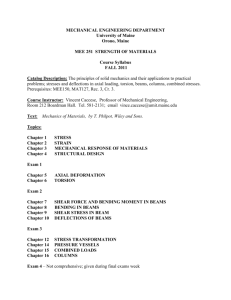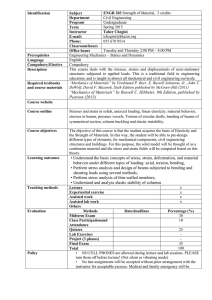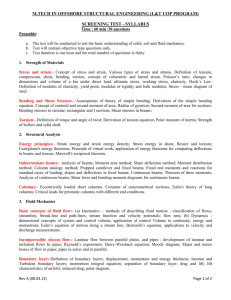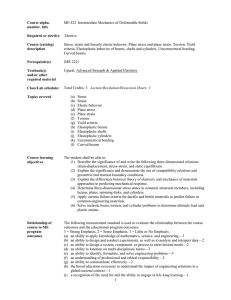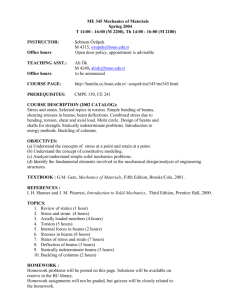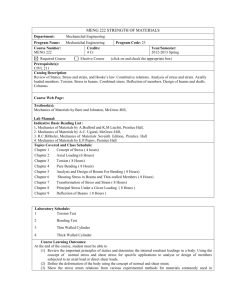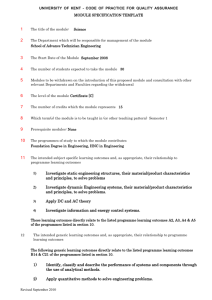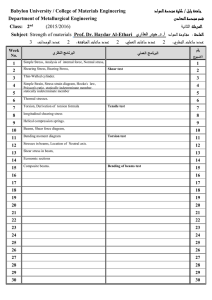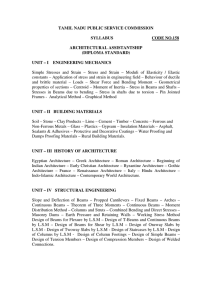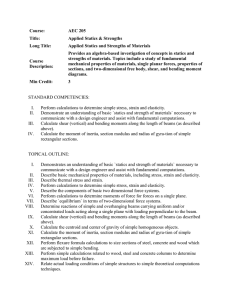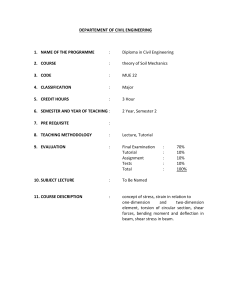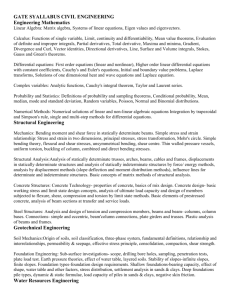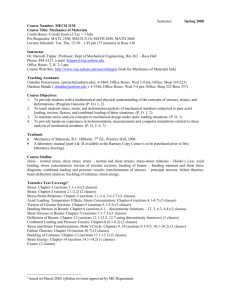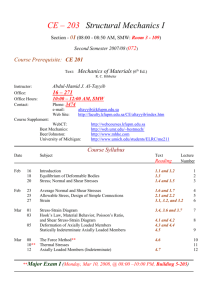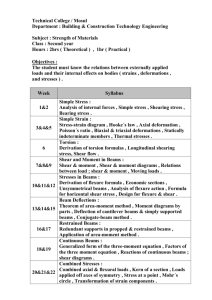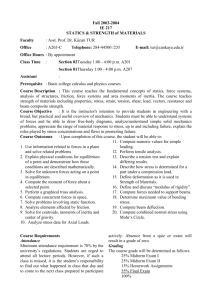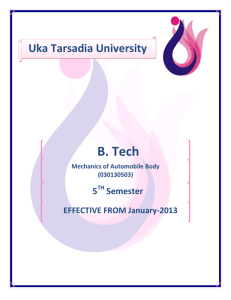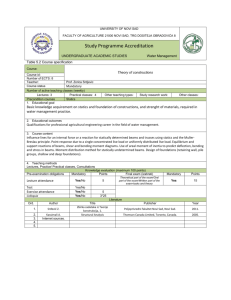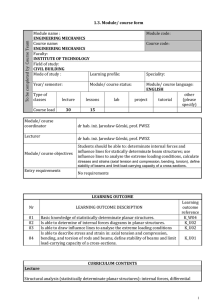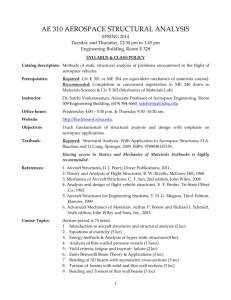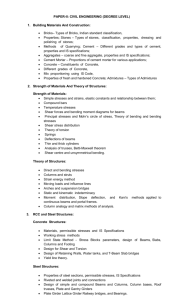0130301W-Structural Analysis
advertisement
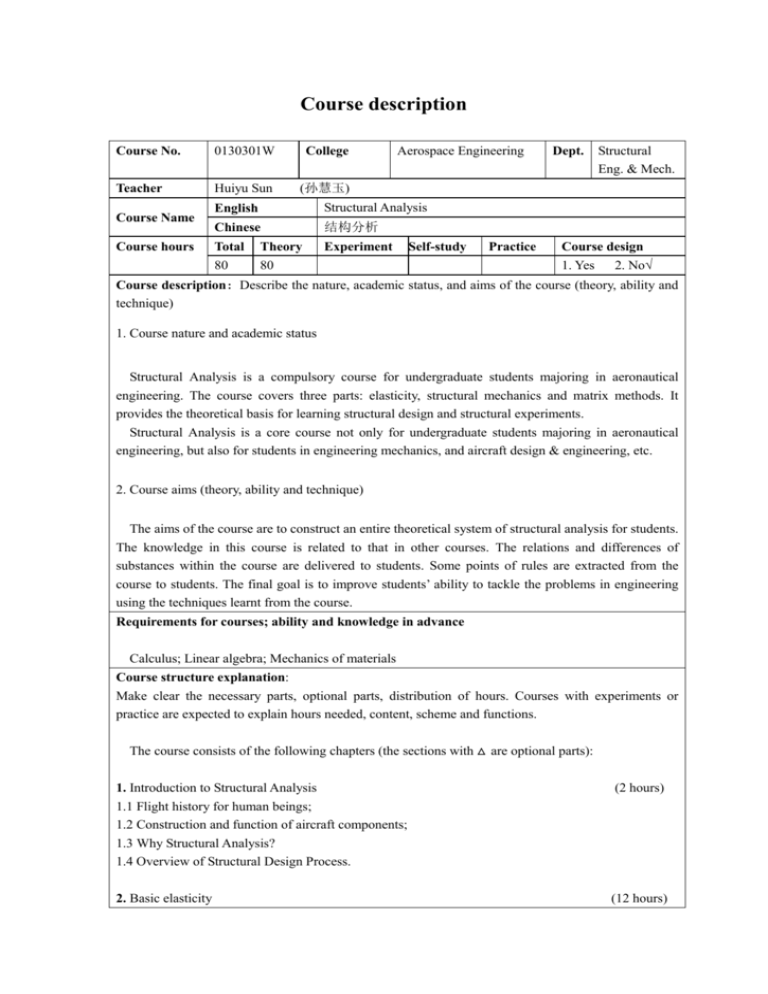
Course description Course No. 0130301W College Teacher Huiyu Sun (孙慧玉) Course Name Course hours Aerospace Engineering English Structural Analysis Chinese 结构分析 Total Theory Experiment 80 80 Self-study Practice Dept. Structural Eng. & Mech. Course design 1. Yes 2. No√ Course description:Describe the nature, academic status, and aims of the course (theory, ability and technique) 1. Course nature and academic status Structural Analysis is a compulsory course for undergraduate students majoring in aeronautical engineering. The course covers three parts: elasticity, structural mechanics and matrix methods. It provides the theoretical basis for learning structural design and structural experiments. Structural Analysis is a core course not only for undergraduate students majoring in aeronautical engineering, but also for students in engineering mechanics, and aircraft design & engineering, etc. 2. Course aims (theory, ability and technique) The aims of the course are to construct an entire theoretical system of structural analysis for students. The knowledge in this course is related to that in other courses. The relations and differences of substances within the course are delivered to students. Some points of rules are extracted from the course to students. The final goal is to improve students’ ability to tackle the problems in engineering using the techniques learnt from the course. Requirements for courses; ability and knowledge in advance Calculus; Linear algebra; Mechanics of materials Course structure explanation: Make clear the necessary parts, optional parts, distribution of hours. Courses with experiments or practice are expected to explain hours needed, content, scheme and functions. The course consists of the following chapters (the sections with △ are optional parts): 1. Introduction to Structural Analysis 1.1 Flight history for human beings; 1.2 Construction and function of aircraft components; 1.3 Why Structural Analysis? 1.4 Overview of Structural Design Process. (2 hours) 2. Basic elasticity (12 hours) 2.1 Assumptions; 2.2 Some concepts; 2.3 Equations of equilibrium; 2.4 Geometrical equations and compatibility equations; 2.5 Physical equations; 2.6 Boundary conditions; 2.7 Saint-Venant’s principle. 3. Two-dimensional problems in elasticity 3.1 Plane stress and Plane strain; 3.2 Basic equations for plane problems; 3.3 Solution for plane problems; 3.4 Inverse and semi-inverse methods. (8 hours) 4. Torsion of solid sections 4.1 Prandtl stress function solution; 4.2 The membrane analogy; 4.3 Torsion of a narrow rectangular strip; 4.4 St. Venant warping function solution. (8 hours) 5. Introduction to energy principles (10 hours) 5.1 Strain energy; 5.2 Complementary strain energy; 5.3 The principle of virtual displacements and the principle of the stationary value of the total potential energy; 5.4 The principle of virtual forces and the principle of the stationary value of the total complementary energy; 5.5 Application of energy principles to structural analysis. 6. Bending of open and closed, thin-walled beams 6.1 Introduction; 6.2 Sign conventions and resolution of bending moments; 6.3 Direct stress distribution due to bending; 6.4 Load intensity, shear force and bending moment relationships; △6.5 Deflections due to bending; 6.6 Approximations for thin-walled sections. (8 hours) 7. Shear of beams (6 hours) 7.1 General stress, strain and displacement relationships for open and single cell closed section thin-walled beams; 7.2 Shear of open section beams; 7.3 Shear of closed section beams. 8. Torsion of beams (4 hours) 8.1 Torsion of closed section beams; 8.2 Torsion of open section beams. 9. Structural idealization 9.1 Principle; 9.2 Idealization of a panel; 9.3 Effect of idealization on the analysis of open and closed section beams. 10. Matrix methods 10.1 Notation; 10.2 Stiffness matrix for an elastic spring; 10.3 Stiffness matrix for two elastic springs in line; 10.4 Matrix analysis of pin-jointed frameworks; 10.5 Application to statically indeterminate frameworks; 10.6 Matrix analysis of space frames; 10.7 Stiffness matrix for a uniform beam; 10.8 Finite element method for continuum structures. (6 hours) (16 hours) Teaching methods (Lectures, practice, etc) The course is delivered using multimedia PPT and blackboards. Some examples are illustrated to show the points of knowledge in each chapter. Problems of new concepts, principles and methods are assigned as homework. Forms of examination and requirements Structure of the final grade(including presence, class performance, ), focus of exam, forms of exam(test, interview, final report, etc) The final grades are composed of three parts: 15% based on attendance, 15% based on homework assignments, and 70% based on a final exam. For the final exam, books and notes are generally closed. Title Textbook References Publisher Author Year Butterworth-Heinemann T.H.G. Megson 2007 Title Publisher Author Year Theory of Elasticity McGraw-Hill Timoshenko and Goodier 1970 Theory and Analysis of Flight Structures McGraw-Hill Rivello 1969 Aircraft Structures Engineering Students for Website Under construction Course members Huiyu Sun, Zhiyu Shi, and Bin Zhang, etc. College Aerospace Engineering Price Price
